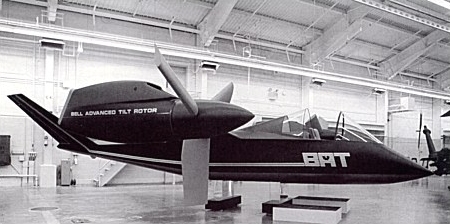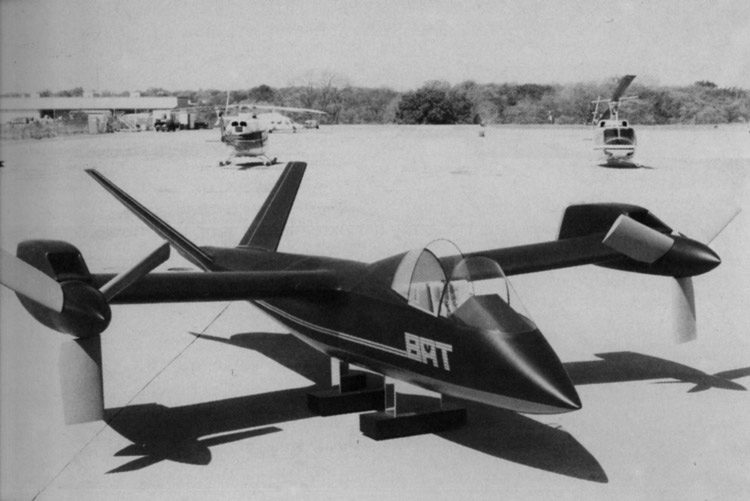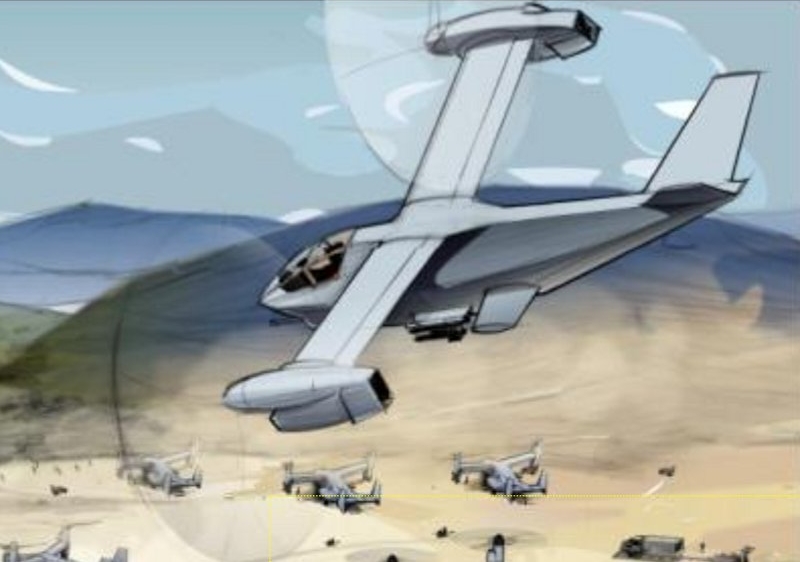|
The BAT demonstrator was merely a full-scale mock-up.
Artist's concept of the BAT demonstrator in operation.
Two projected LHX-type proposals directly derived from the BAT design. |
BELL TEXTRON D-329 BAT (Bell Advanced Tilt-rotor) Info: advanced tilt-rotor demonstrator Powerplant: not known Significant date: 1984 The Bell Advanced Tilt Rotor (or BAT) was a lightweight advanced, single seat, tilt-rotor aircraft proposed in 1984 by Bell in response to the US Army's LHX program. The Light Helicopter Experimental (LHX) combat helicopter program was initiated in 1983 to replace the Army's rapidly aging fleet of UH-1, OH-58A Kiowa scout and AH-1 Cobra light attack helicopters. At the time, as many as 6,000 helicopters were envisioned. The Scout/Attack (SCAT) was the design driver; the utility was to be derived from the SCAT. To fulfil the missions undertaken by the existing fleet, different LHX models were to be equipped with a large variety of new technologies and mission equipment packages. A light survivable, lethal, armed reconnaissance helicopter, the LHX combat helicopter was to have greater capabilities, new sensors, millimeter wave radar, and other advance features in a high visibility cockpit. Maximum use was to made of computer-aided design of the LHX and systems as an integrated whole. To support the Army’s concept exploration activities, competitive preliminary design contracts were awarded in September 1983 to the four major helicopter firms - Bell Helicopter Textron, Sikorsky Aircraft, Boeing Vertol and Hughes Helicopter to define specific aircraft system configurations (point designs). Contracts were also awarded m December 1983 to define the advanced/integrated cockpit design and architecture and demonstrate the feasibihty of a single-pilot LHX Scout/Attack through full-mission simulations. These contracts were awarded to the four major helicopter firms and to IBM. Boeing had not completely decided which way they were going to go, but also had a Tilt-Rotor design in the works. The BAT was a small tilt-rotor aircraft demonstrator with a butterfly tail unit. Development of the BAT had to be abandoned due to new LHX requirements, especially in the matter of weight (LHX had to be under 3150 kg). The problem with a BAT (Bell Attack Tiltrotor) or any similar system is that, to make it aerodynamic and light enough to fly agilely, you have to reduce it's fuselage profile considerably. This means you cannot stuff the belly with a weapons bay, particularly on those variants which in fact went with a single T800 turboshaft on the centerline and left the wingtip pods empty. While you can theoretically use superior dropfire technology weapons from these wings, the combination of stiffening for pylons (re-adding weight and roll inertia, outboard) and the fact that clearing the proprotor disks in anything but clean and level flight becomes somewhat 'sporty', tends to argue against the type. According to some observers, for reasons, never explained, Army withdrew the original specifications and "dumbed-down" the requirements to what a regular helicopter could do, and gave no credit performance above that. In addition, they put in certain strictures in (which the Comanche didn't meet, it turned out) to insure a Tilt-Rotor could not win. One possible reason may be that they feared Bell and Boeing would team again and bid one Tilt-Rotor that would dominate the competition and no one else would bid. The net effect of changing the specs also killed any chance for other advanced concepts such as the Hughes ideas. Within the new work frame defined by the Army, Bell continued working on the LHX program and eventually joined McDonnell Douglas as the SuperTeam on a helicopter type that unsuccessfully competed with Boeing and Sikorsky's RAH-66 Comanche. Population: not built (mock-up only) Specs: Crew/passengers: 1 Sources:- The Secret Projects Forum: Link 1 | Link 2 | Link 3 | Link 4 - The Aviastar website |
This website is conceived,
designed and maintained by BIS © 2006-2010 BIS Productions
Although every effort is made to make the information accurate, a mistake is
always possible.
Feel free to send an e-mail to correct or update any page of this site.





